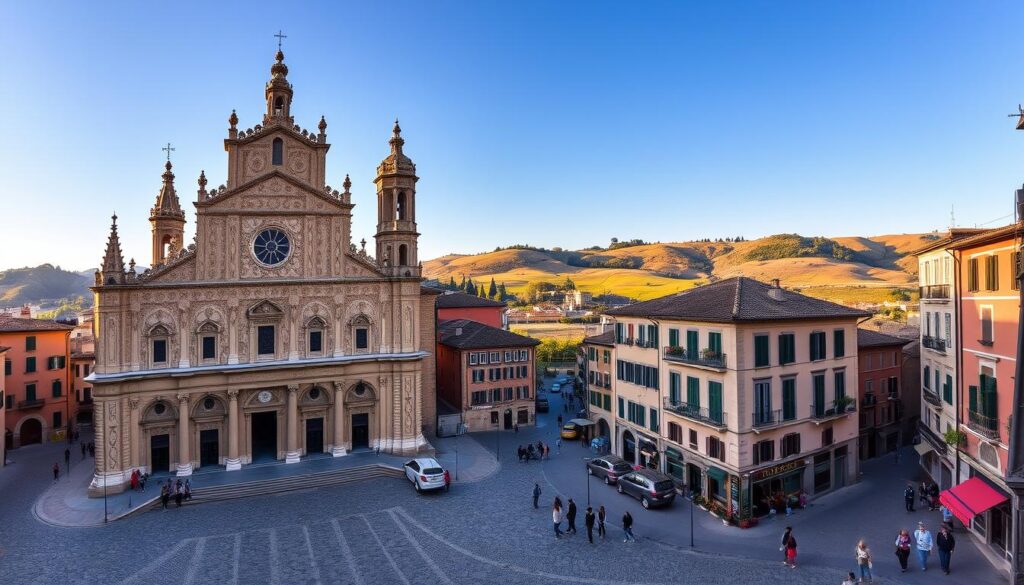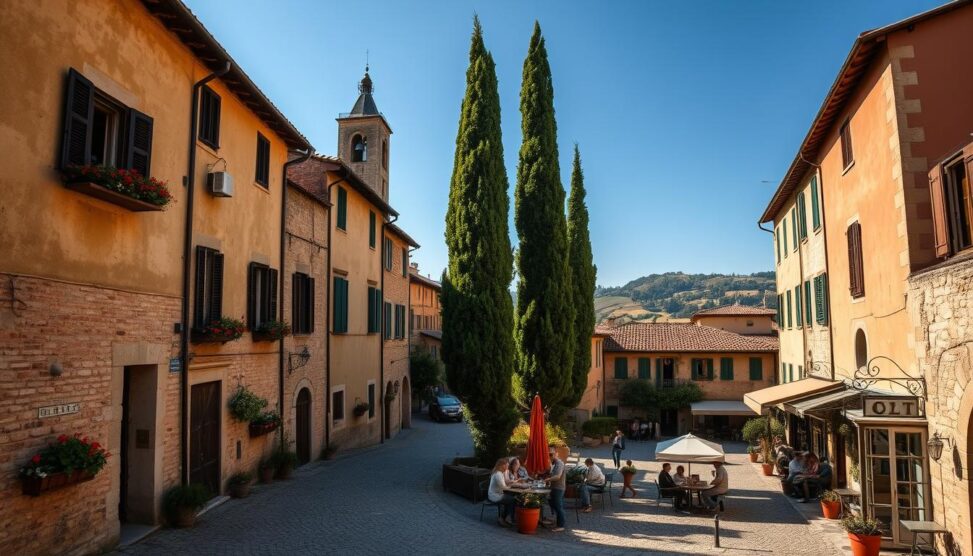Explore your family roots in charming Italian towns. About 17% of Americans have Italian ancestry. Each year, 2.5 million people visit Italy to discover their heritage. An lets you connect with your past and understand your family’s story better.
Walk the same streets your great-grandparents did. Visit the church where they married. Meet relatives who still live in these towns. Heritage travel in Italy immerses you in rich culture and history.
Most travelers say connecting with their heritage improves their experience. This guide will help you plan a meaningful and unforgettable adventure.
Discover five must-visit ancestral Italian towns. Each offers unique history, stunning architecture, and warm hospitality. Learn when to plan your trip for cultural festivals.
Taste local cuisine passed down through generations. Experience your family’s culinary legacy firsthand.
Local guides and genealogists can help uncover hidden stories. They’ll show you ancient castles and preserved churches. Our tips will help you navigate streets and find perfect accommodations.
Join other Americans on this journey of self-discovery. Use this guide to unveil your past and create lasting memories in your ancestral homeland.
Introduction to Ancestral Italian Towns
Italy’s ancestral towns offer a unique experience beyond typical tourist spots. These hidden gems allow visitors to connect with their roots. Explore authentic Italian life in these charming villages.
Ancestral Italian towns preserve traditions and nostalgic atmospheres. Visitors can engage in local customs and savor traditional cuisine. Italian genealogy tours help people uncover their ancestral ties.
Southern Italy’s vital statistics acts date back to the early 1800s. Other regions instituted civil records around 1860. This rich history adds depth to exploring ancestral towns.
Immersing in local culture is crucial for ancestral tourism. Learning Italian enhances genealogical research accuracy. It also allows for deeper connections with locals.
Evening courses can improve your Italian language skills. This preparation will enrich your journey to ancestral towns.
“Visiting my ancestral Italian town was a transformative experience. It allowed me to connect with my roots and gain a deeper understanding of my family’s history.” – Maria, Italian-American traveler
Ancestral Italian towns offer a unique chance to explore your heritage. These villages transport you to a bygone era. You’ll gain appreciation for your ancestors’ way of life.
Create lasting memories as you trace your family lineage. Experience authentic Italian culture in these enchanting villages.
Top Five Ancestral Italian Towns to Visit
Discover hidden gems in Italy’s ancestral towns. These places blend history, architecture, and local traditions. From ancient caves to hilltop villages, each offers a unique experience.
Matera, the City of Stone, is a UNESCO World Heritage Site. Its Sassi district features cave dwellings from Paleolithic times. Explore rock-hewn churches and immerse yourself in rich history.
Civita di Bagnoregio sits atop a hill, accessible by a pedestrian bridge. This medieval town offers stunning valley views. With only a dozen residents, it’s a peaceful escape.
“Visiting Civita di Bagnoregio was like stepping back in time. The narrow streets and ancient buildings transported me to another era.” – Sophia, traveler from New York
Pitigliano, nicknamed Little Jerusalem, has a fascinating Jewish heritage. Explore its historic Jewish quarter and restored synagogue. Tufa rock formations and Etruscan tombs add to its charm.
San Gimignano, a UNESCO site, is known for its 14 medieval towers. Climb Torre Grossa for panoramic views. Enjoy local Vernaccia wine and authentic Tuscan flavors.
Manarola, part of Cinque Terre, offers stunning coastal views. Colorful houses cling to terraced hillsides. Hike the Via dell’Amore and enjoy the seaside town’s natural beauty.
Best Time to Visit Ancestral Italian Towns
Timing is crucial for a great ancestral town experience in Italy. May, June, September, and October offer mild temperatures and fewer crowds. These months provide a perfect mix of pleasant weather and authenticity.
You can fully immerse yourself in your ancestral hometown’s charm. The shoulder seasons allow for a more genuine connection with the local culture.
“Visiting my ancestral village in Italy during the fall was a life-changing experience. The warm colors of the countryside and the opportunity to connect with locals during the harvest season made it an unforgettable journey.”
July and August can be less ideal for ancestral town visits. High temperatures and closed family businesses may limit cultural engagement. However, summer trips can still be rewarding.
Look for local patron saint celebrations during summer visits. These events offer unique cultural experiences tied to religion and community.
Spend at least a week in your ancestral village to truly connect with your heritage. This extended stay allows you to explore the town’s history and participate in traditional activities.
Take cooking classes featuring local dishes and interact with artisans. Many visitors report life-changing experiences during their stays. Some even recognize family resemblances in locals.
Careful planning and ample exploration time create lasting memories. You’ll forge deep connections to your Italian roots during your ancestral town visit.
Local Cuisine: A Taste of Tradition
Italy’s ancestral towns offer a rich culinary heritage. Traditional recipes have been passed down for generations. These local experiences showcase authentic flavors and ingredients from each region.
Visit time-honored trattorias like Zi’ Pasqualina in Naples. It’s been serving affordable home-cooked meals since 1953. Antica Trattoria Di Pietro, open since 1934, survived relocation after a 1960 earthquake.
Savor regional specialties like Abruzzo’s prized L’aquila saffron. It’s been cultivated since the 13th century. Try Liguria’s iconic pesto, made with local basil, pine nuts, and olive oil.
The Irpinia region is famous for its exceptional cured meats. Local prosciutto contributes to the area’s culinary identity. Basilicata’s cuisine uses inexpensive local ingredients creatively.
Try pupazzella, small round hot peppers soaked in vinegar. Calabria’s fiery ‘nduja showcases the importance of regional chili peppers.
“Italian cuisine is not just about the food; it’s a celebration of life, family, and tradition. Every dish tells a story, and every bite is a connection to the past.”
Forage for wild asparagus and truffles in Cilento mountains. Join Chef Mario Stellato at Borgo La Pietraia for this adventure. Learn to craft traditional dishes in cooking classes and farmhouse dinners.
Embrace seasonal eating with dishes like palomba alla ghiotta. It’s traditionally prepared in Umbria during winter. This highlights the link between local agriculture and culinary practices.
Explore Italy’s ancestral towns through their flavors. Each bite reflects the enduring spirit of Italian gastronomy. Let your taste buds guide you through this culinary journey.
Cultural Activities and Festivals
Discover the rich culture of ancestral Italian towns through vibrant festivals and activities. These celebrations showcase deep-rooted heritage and community spirit. From patron saint festivities to seasonal events, there’s always something exciting happening.
Witness religious ceremonies and processions that have shaped local culture for centuries. Streets come alive with colorful decorations, music, and joyous laughter. Residents honor their patron saints and celebrate their faith with enthusiasm.
Seasonal festivals highlight the cultural calendar in these towns. Harvest celebrations showcase the land’s bounty and age-old farming traditions. Visitors can enjoy local delicacies and sample wines from nearby vineyards.
“Participating in the festivals and cultural activities of ancestral Italian towns is like stepping back in time and experiencing the essence of Italy’s rich heritage firsthand.”
Many towns offer workshops with skilled artisans for a hands-on cultural experience. Learn silk spinning, try traditional pottery making, or discover Italian cuisine secrets. These activities connect you with local craftsmanship and the region’s artistic legacy.
Exploring Historical Landmarks
Ancestral Italian towns are full of historical landmarks. They offer a chance to explore rich heritage. Visitors can step back in time and discover fascinating places.

Visitors can trace their ancestors’ footsteps in these towns. They can explore where they lived, worked, and worshipped. Family homes, churches, and archives provide glimpses into the past.
Many towns have records dating back to the 16th century. About 80% of family records are available to the public. This makes it easier for visitors to uncover their family history.
“Exploring the historical landmarks of my ancestral Italian town was a deeply moving experience. It felt like I was connecting with my roots and the stories of my ancestors.” – Maria, a visitor to her ancestral town in Tuscany
Some towns have noble family histories. Hand-painted family trees and historical documents offer fascinating insights. Studies show 40% of Italy’s visitors are interested in genealogy-related tourism.
Over 50% of Tuscan towns preserve medieval structures. Many other Italian heritage sites are scattered throughout the country. Visitors can find a wealth of historical landmarks to explore.
From Rome’s iconic Colosseum to Matera’s sassi cave dwellings, Italy offers unique experiences. Ancestral towns provide an unforgettable journey through history. Each site tells a story of Italy’s rich past.
Getting Around in Ancestral Italian Towns
Exploring ancestral Italian towns can be thrilling. Many are hidden in remote areas with limited public transport. Consider local car services, trains, or rentals to reach your destination.
Once there, walk the charming streets to soak in the town’s unique atmosphere. Plan ahead and check transportation schedules. Allow extra time for delays, as small towns often move slower.
Guided tours combining tourism and genealogy are popular for heritage travelers. These tours offer a comprehensive experience, covering multiple ancestral locations. They often include genealogy workshops and local history tours.
“Visiting my ancestral town made me feel a stronger sense of belonging to my family and culture. It was an incredibly emotional and fulfilling experience.”
Be ready for urban changes that may have altered the landscape. Many ancestral addresses might have been converted or renamed. This adds intrigue to your journey.
Embrace the chance to uncover hidden gems. Connect with locals who can share stories about the town’s history. They may offer insights into your family’s legacy.
Accommodation Options: Where to Stay
Selecting the right lodging is key for an authentic Italian experience. Options range from boutique hotels to cozy guesthouses. Local B&Bs or agriturismos offer genuine hospitality with home-cooked meals and insider tips.

For a unique stay, try a converted cave dwelling in Matera. This UNESCO site offers various accommodations. The Aquatio Cave Luxury Hotel & Spa has 35 rooms.
Sant’Angelo Luxury Resort provides modern cave rooms overlooking the picturesque old town. These options blend history with comfort.
“Staying in a cave hotel in Matera was an unforgettable experience. The room was beautifully restored, and the view of the ancient city was breathtaking.” – Sarah, recent visitor to Matera
Book unique stays on Booking.com, Airbnb, or local tourism websites. Peak season (June to September) has higher costs. Consider shoulder months (April, May, October) for better deals.
Winter months (November to February) offer lower prices and fewer crowds. This allows for a more relaxed exploration of your ancestral town.
Tips for Traveling Responsibly
Discovering your Italian roots requires responsible travel. Support local businesses and respect cultural heritage. Your actions can help preserve charming Italian towns for future generations.
Patronize local restaurants, shops, and artisans to boost the economy. Many small Italian towns face abandonment or depopulation. Your support can help revitalize these areas.
Participate in local festivals and enjoy regional cuisines. This enhances your experience and contributes to the town’s sustainability.
Respect cultural heritage and practices when visiting religious sites. Dress appropriately and follow local customs. Learn about the town’s history and traditions.
Engage with locals respectfully to show appreciation for their culture. This approach fosters meaningful connections and enriches your journey.
“Traveling responsibly is not just about minimizing our negative impact; it’s about actively contributing to the well-being of the communities we visit.”
Consider the long-term effects of your actions while exploring. Choose eco-friendly transportation and reduce waste. Be mindful of your water and energy consumption.
Being a conscientious traveler sets a positive example. It helps preserve these precious towns for future generations to enjoy.
Conclusion: Embrace the Charm of Italy’s Ancestral Towns
Exploring your family roots in Italy is a unique and rewarding experience. Each region offers a glimpse into the rich history that shaped your ancestors’ lives. Connecting with your heritage is deeply personal and meaningful.
Planning your trip is crucial for making the most of your time in Italy. Our team can help craft an itinerary showcasing the best of your ancestral towns. We’ll ensure every moment is filled with discovery and meaning.
As you explore, reflect on the sacrifices and triumphs of those who came before you. The Italian diaspora after World War II changed countless families’ lives. By tracing your roots, you’re keeping their stories alive.
Embrace the charm and beauty of each destination on your ancestral Italian town adventure. Every moment is a chance to create lasting memories and connect with your heritage. The true essence of Italy lies in its people – your people.





Leave a Reply